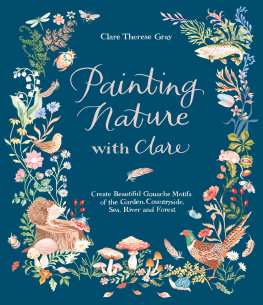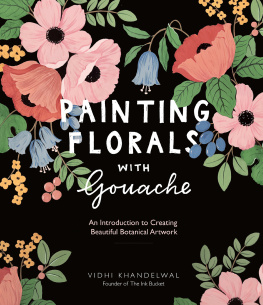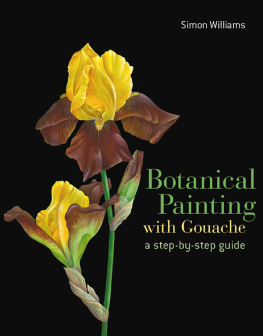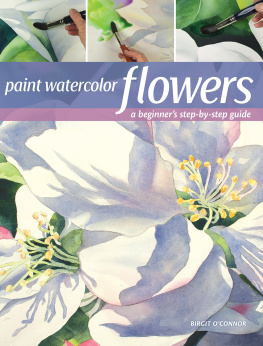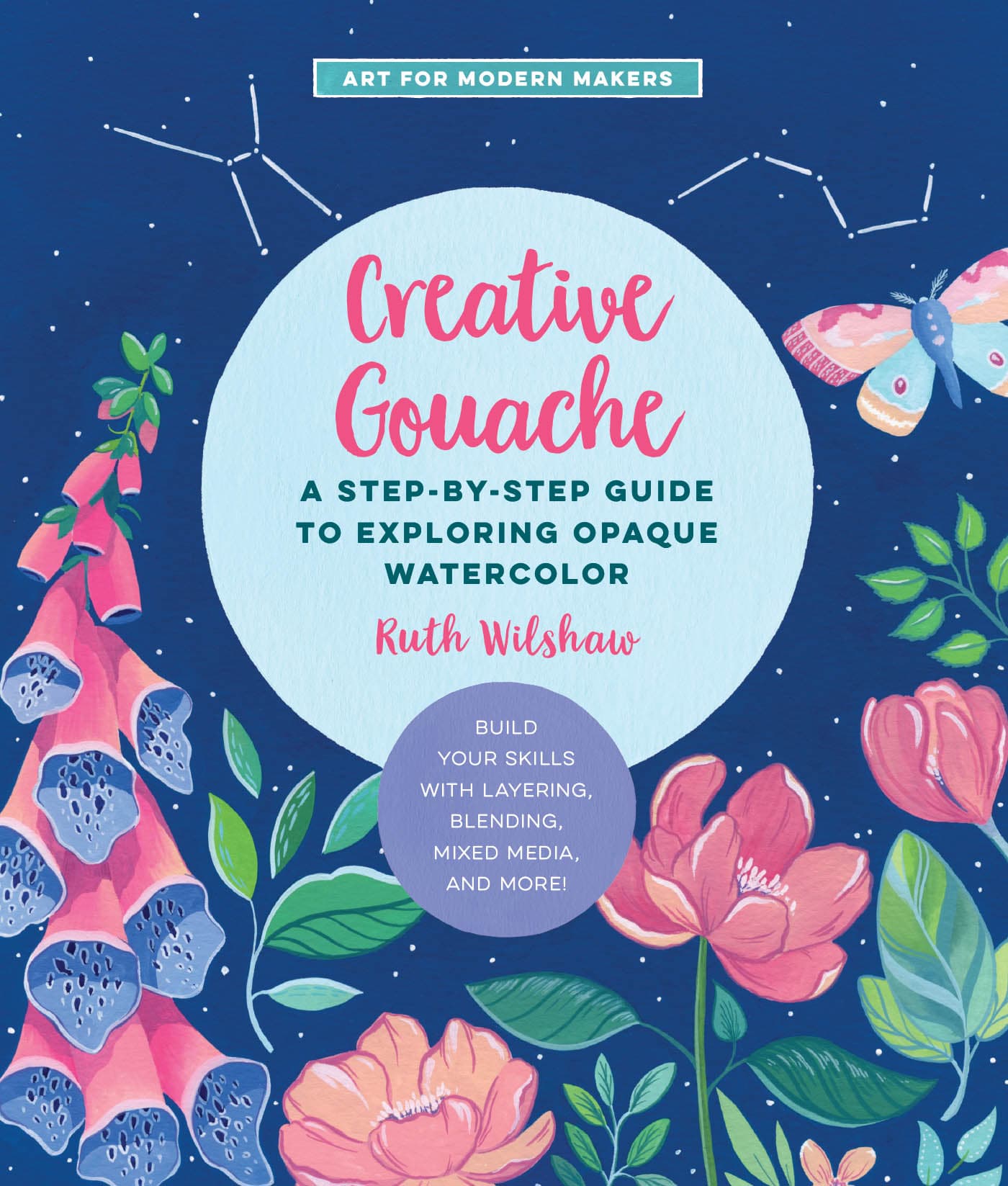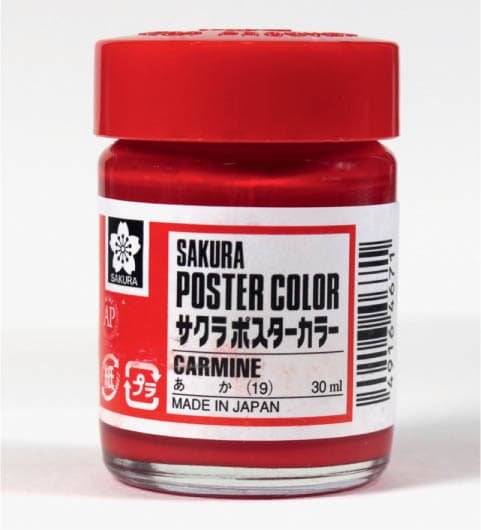Contents
Page List
Guide
Cover
CONTENTS
Types of gouache, paper, brushes, other materials, alternative surfaces, and protecting gouache
The unusual properties of gouache, layering, finding the perfect consistency, and blending
INTRODUCTION
Of all the art techniques and supplies I have tried over the years, none has captured my heart and kindled my creativity like gouache. I stumbled upon this paint by accident and instantly fell in love with its beautiful opacity and velvety matte finish. I had found my medium, and, since then I have encouraged others to try it.
Trying something new can be daunting. It often requires learning new skills and techniques and buying special supplies. But gouache doesnt call for high-end or medium-specific materials, just ordinary paper and brushes to go with the paint.
Gouache does have some quirks that differentiate it from regular watercolors, but its unusual qualities are what make it so special. Youll admire how the little paint tubes are packed with pigment, and how you can create beautiful watercolor-like washes alongside boldly opaque strokes. Youll marvel at the ability to rewet an area to fix a mistake, and youll love the convenience of how quickly it dries in your sketchbook. The paints beautiful matte surface photographs easily for you to share on social media, and on those days when life gets in the way, youll appreciate that a brush left unrinsed is not ruined!
I could talk all day about why youll love gouache, but Id rather you discover it for yourself. This book covers everything youll need to begin exploring the medium, along with a wide range of projects to stimulate your own creativity. Ive developed the techniques and methods shown here over several years. They work for me, but there are other approaches. I encourage you to explore the possibilities of your paints and use the projects in this book as the first steps in discovering the magic of gouache.
ESSENTIAL SUPPLIES
Where better to begin than with the essential supplies youll need to start painting with gouache. In this section, well look at the different kinds of gouache paint, as well as brushes and paper that will help you get the best results. Ill also share a few must-have supplies for your gouache kit, along with some advice for painting on surfaces other than paper.
TYPES OF GOUACHE
When Im asked, What is gouache? I typically respond that its a medium halfway between watercolor and acrylic, with the permanent solubility of the former and the opacity of the latter. There are three kinds of gouache: artists, designers, and acrylic. Theyre all slightly different in formulation, but each provides the beautiful matte finish that you expect from gouache.
- Artists gouache (A) generally has no added opacifiers. The colors are bright and pure, but some of the naturally transparent pigments wont give opaque coverage without adding white. The fine-quality pigments found in artists gouache are the most suited to artwork that will be framed and displayed.
- Designers gouache (B) often has excellent opacity and can be found in a wide range of vibrant colors. Some pigments used in this kind of gouache are not as lightfast as others, meaning they will fade over time when exposed to light. This type of gouache is great for learning and practicing and for painting in a sketchbook. Its also a good option if you want to digitize your work for patterns or prints.
- Acrylic gouache (C) is a matte acrylic paint that dries with the same matte finish as regular gouache, but is waterproof once dry. This makes it an excellent choice for painting on surfaces that you dont want to frame under glass, such as wood panels or canvas. However, dont let acrylic gouache dry on your brushes, or they will be ruined.
BANG FOR YOUR BUCK
When it comes to cost, gouache can be split into two categories: inexpensive sets of paint and expensive single tubes. A major driving factor for price is how the various brands achieve opacity in their paints. The more expensive paints pack in extra pigment and a little chalk for opacity, whereas inexpensive sets tend to contain less pigment and more chalk. For practicing and learning the basics, you dont need to spend a fortune. I used the same inexpensive set for the first year I painted with gouache.
If youre looking for an inexpensive alternative to high-quality acrylic gouache, try matte acrylic craft paint. This will give you the same matte finish, and these paints are often formulated to withstand exposure to bright light and moisture.
AN ALTERNATIVE TO GOUACHE: POSTER COLOR
High quality poster color is a good, though equally expensive, alternative if youre unable to find true gouache paint. Its pigment isnt as finely ground as that of gouache paint, so your results will be more opaque but otherwise the same. Poster color is sold in jars more often than in tubes.
PAPER
Gouache works well on a variety of paper types, but keep in mind that the more water you add to the paint the heavier the paper should be. For most work, 140 lb cold press watercolor paper is a great choice. It has a nice weight and feels firm under your brush. It wont buckle, even if you cover large areas with paint. I find the Canson XL Watercolor pad to be a great inexpensive, everyday paper that comes in a variety of convenient sizes.
Paper Texture
Watercolor paper textures range from smooth to rough, and this varies among manufacturers. Smooth paper is ideal for creating uniform blends and even brush-lettering lines.
Textured paper can add interest to the flat finish of gouache. You can also make the texture of the paper a feature by using a dry-brushing technique to highlight the uneven surface (see ).


